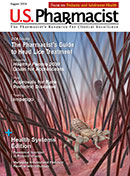The year 2022 marks the hundredth anniversary of the first clinical use of insulin. During this time, there have been numerous advances in insulin-delivery systems, from the early days of a glass syringe and needle to the modern use of insulin pens. Insulin pens offer the advantage of ease of administration, especially for patients with visual and dexterity issues, accuracy when administering small doses, convenience, and reduced pain. Even insulin pens have evolved since the availability of the first insulin pen, NovoPen, in 1985 to the arrival of smart insulin pens and insulin pen caps.
A recent paper examined the past, present, and future of insulin pens. Unlike other parts of the world, the U.S. has been slow to embrace this technology. Only about 59% of patients with diabetes use insulin pens in the U.S. compared with about 94% in Europe. Cost and insurance coverage may contribute to the low penetration of insulin pens in the American insulin market. Specific insulin pens are matched with proprietary brands of insulin and are generally not interchangeable.
The authors described the two most common types of currently available insulin pens: reusable insulin pens and prefilled or disposable insulin pens. Reusable pens have refillable cartridges that are reloaded by the patient prior to use, whereas disposable pens contain prefilled cartridges, resulting in the pen being discarded once the cartridge is spent. Both types of pens contain a maximum of 3 mL of insulin and can deliver insulin in increments as small as 0.5 mL. Early insulin pens were only designed to administer short-acting insulins.
The initial reusable insulin pen, NovoPen, contained a 1.5-mL cartridge. NovoPen 2, which became available in 1988, allowed for the administration of Neutral Protamine Hagedorn (NPH) insulin and premixed insulins but only had a capacity of 36 insulin units. NovoPen 3 improved on that, holding up to 70 units of insulin and eliminating insulin waste.
These reusable pens were followed by NovoPen 1.5, NovoPen 3 Demi, NovoPen Junior (indicated for children), NovoPen 4, HumaPen, OptiPen, ProOptiClik, ClikSTAR, and HumaPen Ergo. The AutoPen mechanism allowed for reduced force to be applied to deliver the insulin in the pen. This mechanism was incorporated into the GensuPen and GensunPen 2. In 2008, the first digital insulin pen with a memory function, the HumaPen Memoir, was marketed, followed by the NovoPen Echo in 2010, which also had memory function and a half-unit dosing feature.
The first disposable insulin pen, NovoLet, was launched in 1989. Since then, other prefilled pens that have become available, including FlexPen, Next Generation FlexPen, FlexTouch, SoloSTAR, KwikPen, and Junior KwikPen. Concentrations of insulin other than 100 units/mL that can be found in prefilled pens include 200 units/mL as in Humalog 200 U/mL KwikPen and Tresiba 200 U/mL prefilled FlexTouch, and 300 units/ml in Glargine U300 SoloSTAR.
While prefilled or disposable insulin pens are convenient, they are not environmentally friendly.
Next-generation insulin pens include "smart insulin pens." These insulin pens are digitally connected pens that store and transmit data to the user's mobile device or smartphones regarding the time and amount of insulin administered. They can also send the insulin user reminders and help patients calculate bolus doses. These pens are Bluetooth-enabled. Besides delivering real-time information, they eliminate the need for paper logs, which can often get misplaced or lost.
The first smart pen in the world, the InPen, was approved by the FDA in 2017. This was followed in 2020 by the release of another version of the InPen that can generate reports about missed doses, the amount of insulin left in the pen, and temperature excursions that can affect the potency of the insulin. Additional smart insulin pens include ESYSTA, Pendiq 2.0, and NovoPen 6.
Another innovation in insulin delivery are insulin pen caps. These devices display the quantity of insulin in the pen and integrate insulin-related information with a patient's mobile app. The insulin pen cap either attaches to the side of the pen or on the end of the pen. The first such device was approved by the FDA in May 2021. It is the Bigfoot Unity Diabetes Management System and it is integrated with the FreeStyle Libre 2 system. It performs continuous glucose monitoring, sends medication reminders, and calculates dosing recommendations. Other insulin pen cap devices include GoCap (which is also FDA-approved), Insulclock, Timesulin, and Dukada Trio.
This article provides pharmacists with concise charts summarizing clinical trials on these different devices. It serves as a valuable resource for pharmacists caring for patients who use any type of insulin pen or insulin pen cap.
The content contained in this article is for informational purposes only. The content is not intended to be a substitute for professional advice. Reliance on any information provided in this article is solely at your own risk.
« Click here to return to Infusion Pharmacy Update.






